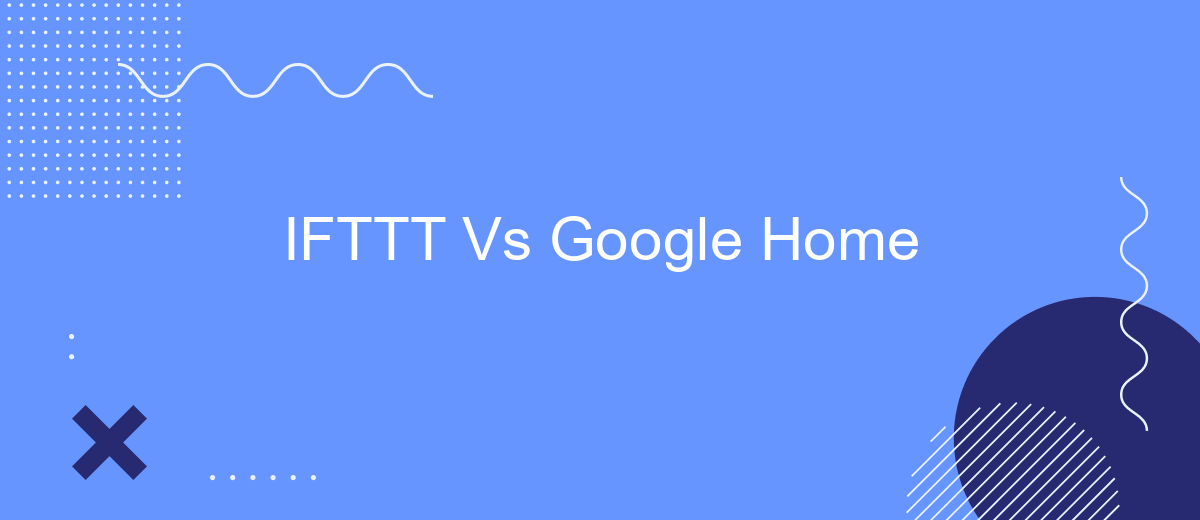In today's smart home landscape, automation tools like IFTTT and Google Home play pivotal roles in enhancing convenience and connectivity. While both platforms offer unique features, understanding their differences and capabilities can help users make informed decisions. This article delves into a detailed comparison of IFTTT and Google Home, exploring their strengths, weaknesses, and ideal use cases for a smarter living experience.
Introduction: Understanding IFTTT and Google Home
In today's interconnected world, automation platforms like IFTTT and Google Home are becoming increasingly essential. These tools help streamline various tasks, making our lives more efficient and convenient. Understanding the differences and similarities between IFTTT and Google Home can help you decide which platform best suits your needs.
- IFTTT (If This Then That): A web-based service that allows users to create chains of simple conditional statements, called applets, to automate tasks across different apps and devices.
- Google Home: A smart speaker powered by Google Assistant that enables voice-controlled automation of smart home devices and access to various Google services.
Both IFTTT and Google Home offer unique advantages. While IFTTT excels in creating customized automation across a wide range of apps and services, Google Home focuses on voice-activated control within the Google ecosystem. Tools like SaveMyLeads can further enhance your automation experience by simplifying the integration process between different platforms and services, making it easier to keep everything in sync.
Integration Capabilities: Exploring the Possibilities

When comparing IFTTT and Google Home, one of the most crucial aspects to consider is their integration capabilities. IFTTT (If This Then That) offers a flexible platform that allows users to create custom automation workflows between various apps and devices. It supports a wide range of services, making it a versatile tool for those looking to streamline their daily tasks. Google Home, on the other hand, integrates seamlessly with Google services and smart home devices, providing a more cohesive experience for users already embedded in the Google ecosystem.
Both platforms offer unique strengths in terms of integration. IFTTT's extensive library of applets and compatibility with numerous third-party services, such as SaveMyLeads, allows for highly personalized automation setups. SaveMyLeads, for instance, can help users automate lead management processes, enhancing productivity. Google Home excels in voice-activated controls and smart home management, making it an excellent choice for those looking for a hands-free, intuitive experience. Ultimately, the choice between IFTTT and Google Home will depend on individual needs and preferences regarding integration and automation capabilities.
Smart Home Automation: Enhancing Convenience

Smart home automation has revolutionized the way we manage our daily tasks, offering unprecedented levels of convenience and efficiency. With tools like IFTTT and Google Home, users can seamlessly integrate various smart devices and services to create a cohesive and responsive home environment.
- IFTTT: This versatile platform allows users to create "applets" that trigger actions based on specific conditions. For example, you can set your lights to turn on when you arrive home or receive a notification when your laundry is done.
- Google Home: Leveraging Google Assistant, this service enables voice-activated control of compatible devices. You can ask Google Home to adjust your thermostat, play music, or even provide weather updates.
- SaveMyLeads: This service simplifies the integration process by automating the transfer of leads from various platforms to your CRM, ensuring you never miss an important connection.
By combining the strengths of these tools, homeowners can create a smart home ecosystem that not only enhances convenience but also improves overall quality of life. Whether you're using voice commands or automated triggers, smart home automation offers endless possibilities for customization and control.
Customization and Flexibility: Exploring Unique Features

When comparing IFTTT and Google Home, customization and flexibility are crucial aspects to consider. Both platforms offer unique features that cater to different user needs and preferences.
IFTTT excels in providing a wide range of applets that users can customize to automate various tasks across multiple services. This flexibility allows users to create highly specific automation workflows. On the other hand, Google Home offers seamless integration with Google's ecosystem, making it easy to control smart home devices using voice commands.
- IFTTT: Customizable applets for various services
- Google Home: Voice-controlled smart home integration
- SaveMyLeads: Streamlined integration setup for businesses
SaveMyLeads is a valuable tool for users looking to simplify the process of setting up integrations. It provides an intuitive interface for connecting various services, making it easier for users to achieve their desired automation without extensive technical knowledge. This service complements both IFTTT and Google Home by enhancing their customization capabilities.
Conclusion: Determining the Ideal Choice
In conclusion, the choice between IFTTT and Google Home ultimately depends on your specific needs and preferences. IFTTT excels in its versatility, offering a wide range of applets that connect various services and devices. It's an excellent choice for users who want to create customized automations without delving into complex programming. On the other hand, Google Home provides a more integrated experience for those who are deeply embedded in the Google ecosystem, offering seamless control over smart home devices through voice commands and the Google Home app.
For those looking to streamline and enhance their automation processes, services like SaveMyLeads can be incredibly beneficial. SaveMyLeads simplifies the integration of various platforms, making it easier to automate tasks and workflows without extensive technical knowledge. By leveraging such services, users can maximize the potential of both IFTTT and Google Home, ensuring a more efficient and interconnected smart home experience. Ultimately, the best choice will depend on how you prioritize ease of use, customization, and integration capabilities.
- Automate the work with leads from the Facebook advertising account
- Empower with integrations and instant transfer of leads
- Don't spend money on developers or integrators
- Save time by automating routine tasks
FAQ
What is the main difference between IFTTT and Google Home?
Can I use IFTTT with Google Home?
Do I need technical skills to use IFTTT or Google Home?
Can I automate tasks without using IFTTT or Google Home?
Which is better for home automation: IFTTT or Google Home?
Personalized responses to new clients from Facebook/Instagram. Receiving data on new orders in real time. Prompt delivery of information to all employees who are involved in lead processing. All this can be done automatically. With the SaveMyLeads service, you will be able to easily create integrations for Facebook Lead Ads and implement automation. Set up the integration once and let it do the chores every day.

